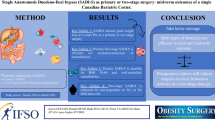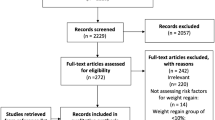Background: Since its introduction about 10 years ago, and because of its encouraging early results regarding weight loss and morbidity, laparoscopic gastric banding (LGB) has been considered by many as the treatment of choice for morbid obesity. Few long-term studies have been published. We present our results after up to 8 years (mean 74 months) of follow-up. Methods: Prospective data of patients who had LGB have been collected since 1995, with exclusion of the first 30 patients (learning curve). Major late complications are defined as those requiring band removal (major reoperation), with or without conversion to another procedure. Failure is defined as an excess weight loss (EWL) of <25%, or major reoperation. Results: Between June 1997 and June 2003, LGB was performed in 317 patients, 43 men and 274 women. Mean age was 38 years (19-69), mean weight was 119 kg (79-179), and mean BMI was 43.5 kg/m2 (34-78). 97.8% of the patients were available for follow-up after 3 years, 88.2% after 5 years, and 81.5% after 7 years. Overall, 105 (33.1%) of the patients developed late complications, including band erosion in 9.5%, pouch dilatation/slippage in 6.3%, and catheter- or port-related problems in 7.6%. Major reoperation was required in 21.7% of the patients. The mean EWL at 5 years was 58.5% in patients with the band still in place. The failure rate increased from 13.2% after 18 months to 23.8% at 3, 31.5% at 5, and 36.9% at 7 years. Conclusions: LGB appeared promising during the first few years after its introduction, but results worsen over time, despite improvements in the operative technique and material. Only about 60% of the patients without major complication maintain an acceptable EWL in the long term. Each year adds 3-4% to the major complication rate, which contributes to the total failure rate. With a nearly 40% 5-year failure rate, and a 43% 7-year success rate (EWL >50%), LGB should no longer be considered as the procedure of choice for obesity. Until reliable selection criteria for patients at low risk for long-term complications are developed, other longer lasting procedures should be used.
Similar content being viewed by others
Author information
Authors and Affiliations
Rights and permissions
About this article
Cite this article
Suter, M., Calmes, J.M., Paroz, A. et al. A 10-year Experience with Laparoscopic Gastric Banding for Morbid Obesity: High Long-Term Complication and Failure Rates. OBES SURG 16, 829–835 (2006). https://doi.org/10.1381/096089206777822359
Published:
Issue Date:
DOI: https://doi.org/10.1381/096089206777822359




